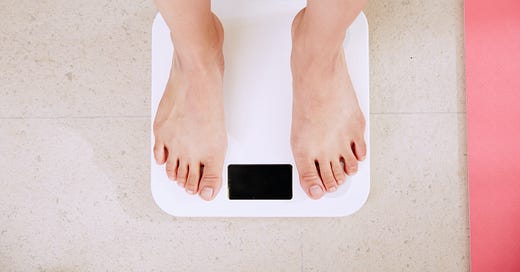There are many ways to measure body composition to gauge whether your strategy leads to progression, maintenance or regression. Next week, I will run through some of the popular assessment methods, but it’s only fitting to start out with the most common - a set of scales.
Measuring body weight using scales isn’t the gold standard for assessing body composition, but it’s still a valuable and accessible way to evaluate your progress. Many people manage body composition successfully using only a set of scales and their accessibility and ease of use make them ideal for ongoing assessments.
But let’s start by discussing when scales aren't the best.
The scales aren’t always perfect
The scales indicate total body mass (TBM) without providing insights into changes in body composition. If you cut carbs from your diet for a few days, TBM will reduce by a couple of kilograms because the body goes through its stored carbohydrate (glycogen) which also releases water.
The scales will show a couple of kilograms of weight loss, but there are no changes in body fat or muscle, which are the targets of most body recomposition strategies.
On the other hand, you can have significant changes in body composition such as losing 10kg of body fat and gaining 2kg of muscle mass, which is achievable for someone new to resistance training over a 4-6 month period.
The scales show a change of -8kg however, there is a significant difference in body composition if you 8kg without muscle gain, compared to losing 10kg and gaining 2kg of muscle. This is where other body composition assessments can be helpful in tandem with body weight.
But they are pretty good in the long run
Body weight becomes more reliable for people who have been training for 12-24 months plus, as they have a solid muscle base and the rate of muscle gain slows. While daily fluctuations in body weight can be based on fluid retention, TBM typically correlates with body composition over longer periods.
Most clients and I use body weight to monitor changes in body composition. It’s quick, simple and gives an accurate idea. These might be complemented by more advanced body composition screening, which I’ll touch on next week.
How often to measure
We know that weight can fluctuate daily, predominately based on fluid retention, which tells us nothing about changes in body fat or muscle mass. Selecting a suitable timeframe for measurement is essential to determine the accuracy of potential changes.
Those who have been reading my articles for a while will be familiar with the story of when I tracked body weight daily during an eight-week weight loss program. However, the story clearly illustrates the limitations of measuring body weight too frequently, so I like to share it.
People who measure too frequently often make decisions based on poor information. They might eat well, but the next day their weight is higher than the previous, so they change their diet to eat less that day. However, this impacts their ability to exercise and then leads to deviation from the program.
As you will see, measuring less frequently gives better insight into the long-term outcome of adherence to the body recomposition strategy.
Bodyweight doesn’t always do what you expect
In 2018, I ran the numbers on my program that was using daily weigh-ins. Over eight weeks, I lost a total of 3.9 kg, which works out to be an average of around 70g per day. However, the data came up with some interesting results, as can be seen in the chart below.
49.1% of daily check-ins saw a decrease in weight from the previous day.
40% of days showed a gain in weight from the previous day.
10.9% showed no change in weight from the previous day.
Although weight decreased significantly over the eight-week program, the likelihood that weight had moved up or down daily was roughly 50%. As can be seen from the chart, body weight fluctuated daily even though the overall result was a significant decrease.
This chart reinforces that weight loss is not linear — it doesn’t decrease at the same rate every day, even if training and nutrition are identical between two days.
While energy balance may be the same, there are factors other than muscle and fat that contribute to body composition and total body weight such as water retention, food intake and even bowel movements. Therefore, you should be wary of weighing in too often.
An increase on the scales can be disheartening, even when you know that weight fluctuates daily and is just a data point. I recommended weighing in every couple of weeks and focusing on implementing the strategy, not weight changes.
A longer time frame between weigh-ins enhances the association between the most-recent reading and the overall trend.
Using the data from the same chart, we see that body weight was lower than the previous week on seven of eight occasions and the fortnightly change decreased on four of four occasions over the eight-week period.
The elimination of normal day-to-day fluctuations will allow you to gain a more accurate understanding of your progress.
How to use scales effectively
You need to ensure weighing in at a consistent time, preferably in the morning, as food and fluid intake will alter your weight throughout the day. Be sure to remove all clothing or wear the same clothing for each measurement.
Muscle glycogen levels can fluctuate across the week, particularly after consecutive days of heavy training, which can also lead to changes in body weight.
If you weigh yourself when glycogen is depleted and again a few days later when full, there could be a 1–2 kg difference from the glycogen alone, as each gram of glycogen retains 3–4 ml of water alongside it.
Check scale weight 1–4 times per month.





